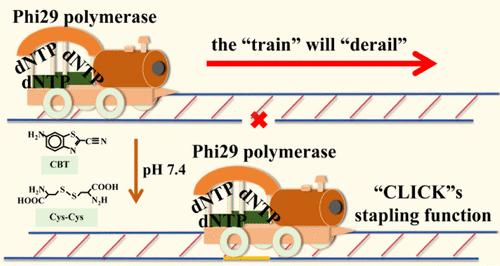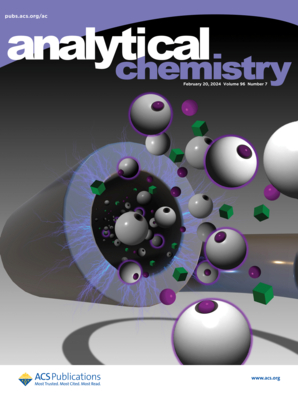Target-Navigated CBT–Cys “Stapling” Coupled with CRISPR/Cas12a Amplification for the Photoelectrochemical Nucleic Acid Assay
IF 6.7
1区 化学
Q1 CHEMISTRY, ANALYTICAL
引用次数: 0
Abstract
Generally, rolling circle amplification (RCA) is based on an enzyme-linked padlock extension reaction. Herein, rapid linking that utilizes click chemistry for joining sticky ends of DNA molecules was developed. The ends of nucleic acid were modified with 2-cyano-6-aminobenzothiazole (CBT) and cystine (Cys–Cys), while glutathione was introduced to break the disulfide bond under target navigation and promote the linkage between CBT and Cys at the terminus of the nucleic acid at pH 7.4. Subsequently, RCA was performed using phi29 polymerase. CRISPR/Cas12a cleavage was triggered by the product of RCA amplification. Assisted by alkaline phosphatase, the electron exchange process between the photoelectroactive Sb@Co(OH)F nanorod and p-aminophenol (p-AP) was collected in the form of photoelectrochemical (PEC) signals. Mass spectrometry, gel electrophoresis, and PEC signals were employed to verify the linking process and the RCA coupled with CRISPR/Cas12a cleavage amplification. CBT–Cys connection exhibited a high reaction rate (23.79 M–1·s–1). This enzyme-free linking process was superior to traditional enzyme catalysis in terms of the reaction environment and linking rate. This efficient nonenzymatic joining system holds great potential for constructing nonhomologous end joining, modifying DNA with molecules, and facilitating nucleic acid–protein modification processes.

用于光电化学核酸测定的靶标导航 CBT-Cys "订书钉 "与 CRISPR/Cas12a 扩增相结合
一般来说,滚圆扩增(RCA)是基于酶联挂锁延伸反应。在此,我们开发了利用点击化学连接 DNA 分子粘性末端的快速连接技术。核酸末端用 2-氰基-6-氨基苯并噻唑(CBT)和胱氨酸(Cys-Cys)修饰,同时引入谷胱甘肽在目标导航下断开二硫键,并在 pH 值为 7.4 的条件下促进核酸末端 CBT 和 Cys 之间的连接。随后,使用 phi29 聚合酶进行 RCA。CRISPR/Cas12a 的裂解是由 RCA 扩增的产物触发的。在碱性磷酸酶的辅助下,光电活性 Sb@Co(OH)F纳米棒与对氨基苯酚(p-AP)之间的电子交换过程以光电化学(PEC)信号的形式被收集。质谱分析、凝胶电泳和 PEC 信号被用来验证连接过程和 CRISPR/Cas12a 裂解扩增耦合的 RCA。CBT-Cys 连接显示出很高的反应速率(23.79 M-1-s-1)。这种无酶连接过程在反应环境和连接速率方面都优于传统的酶催化反应。这种高效的非酶连接系统在构建非同源末端连接、用分子修饰 DNA 以及促进核酸-蛋白质修饰过程方面具有巨大潜力。
本文章由计算机程序翻译,如有差异,请以英文原文为准。
求助全文
约1分钟内获得全文
求助全文
来源期刊

Analytical Chemistry
化学-分析化学
CiteScore
12.10
自引率
12.20%
发文量
1949
审稿时长
1.4 months
期刊介绍:
Analytical Chemistry, a peer-reviewed research journal, focuses on disseminating new and original knowledge across all branches of analytical chemistry. Fundamental articles may explore general principles of chemical measurement science and need not directly address existing or potential analytical methodology. They can be entirely theoretical or report experimental results. Contributions may cover various phases of analytical operations, including sampling, bioanalysis, electrochemistry, mass spectrometry, microscale and nanoscale systems, environmental analysis, separations, spectroscopy, chemical reactions and selectivity, instrumentation, imaging, surface analysis, and data processing. Papers discussing known analytical methods should present a significant, original application of the method, a notable improvement, or results on an important analyte.
 求助内容:
求助内容: 应助结果提醒方式:
应助结果提醒方式:


